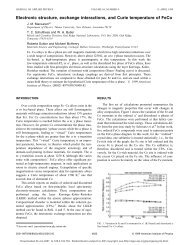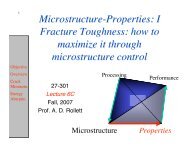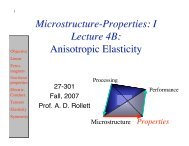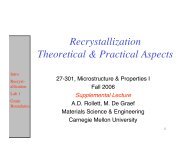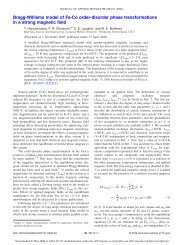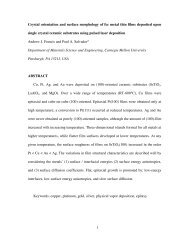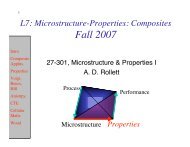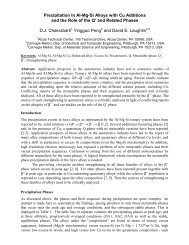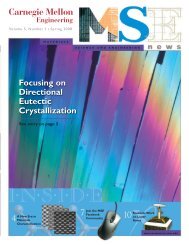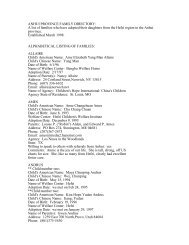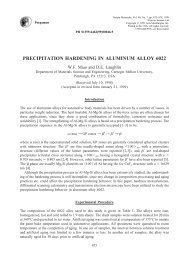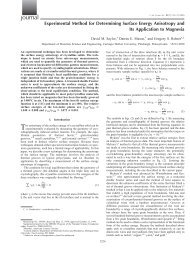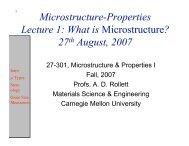CMU News (Page 2) - Materials Science and Engineering ...
CMU News (Page 2) - Materials Science and Engineering ...
CMU News (Page 2) - Materials Science and Engineering ...
Create successful ePaper yourself
Turn your PDF publications into a flip-book with our unique Google optimized e-Paper software.
Robot-Controlled Metallography<br />
A Step Toward Automated 3-D <strong>Materials</strong> Characterization<br />
In August 2007, the Department of <strong>Materials</strong> <strong>Science</strong> <strong>and</strong> <strong>Engineering</strong><br />
placed an order with UES, Inc., in Beavercreek, Ohio, for the<br />
construction of an automated metallography device known as<br />
Robo-Met.3D.<br />
This tool, designed by Jonathan Spowart <strong>and</strong> his colleagues at Wright<br />
Patterson Air Force Base (WPAFB) in Dayton, Ohio, employs a robot<br />
arm with six degrees of freedom to approximate what a human<br />
metallographer would do by h<strong>and</strong>.<br />
While manually obtaining a single 2-D metallographic section is a<br />
routine operation that should be familiar to all MSE graduates, obtaining<br />
a large number of consecutive sections—known as serial sectioning—is<br />
time-consuming (not to men-<br />
“ While manually obtaining tion mind-numbing). To speed<br />
a single 2-D metallographic up this process, the Robo-<br />
Met.3D uses a robot arm<br />
section is a routine operation<br />
which moves the sample, with<br />
that should be familiar to all<br />
a high degree of accuracy <strong>and</strong><br />
MSE graduates, obtaining a large reproducibility, between the<br />
number of consecutive sections— main stations shown in Figure<br />
known as serial sectioning—is 1: the polishing unit, the etch-<br />
time-consuming. ing/rinsing/drying unit, <strong>and</strong> the<br />
”<br />
optical microscope.<br />
A typical cycle consists of three distinct steps. First, the robot arm<br />
mounts the sample on a stage that lowers it to the surface of a precision<br />
polishing unit, where it is polished for a set time. Next, the robot<br />
arm moves the sample through a series of rinsing <strong>and</strong> drying steps—<br />
with a potential acid etch in between these steps. Finally, the sample is<br />
moved onto a high-precision x-y stage mounted above a Zeiss metallographic<br />
microscope, where one or more images are automatically<br />
recorded <strong>and</strong> stored. Large areas can be imaged by means of an image<br />
stitching procedure.<br />
The entire operation is then repeated until the preset number of<br />
sections has been obtained. After the images have been acquired, additional<br />
image processing steps are needed to register the entire 3-D<br />
stack <strong>and</strong> produce a true 3-D digital microstructure. The Robo-Met.3D<br />
instrument shortens the data acquisition time from several months of<br />
manual work to a few days of unsupervised operation.<br />
There are currently only two other Robo-Met.3D instruments in<br />
use. One is at WPAFB, <strong>and</strong> one is at Ohio State University in Columbus,<br />
Ohio. MSE’s instrument, which was acquired with AFOSR DURIP funding,<br />
will be installed in January 2008, <strong>and</strong> will be equipped with an additional<br />
Laue X-ray unit. This unit will consist of a precision x-y stage, a<br />
Figure 1: The Robo-Met.3D device features a polishing unit, an<br />
etching/rinsing/drying unit, <strong>and</strong> an optical microscope.<br />
micro-focus high-intensity X-ray tube, <strong>and</strong> a CCD camera for recording<br />
reflection Laue patterns.<br />
Using customized software, the Laue patterns will be indexed automatically<br />
so that, in addition to microstructural information, the unit will<br />
also be able to produce orientational data. The instrument will be<br />
housed in the lab of Professor Marc De Graef in Roberts<br />
<strong>Engineering</strong> Hall. It will be used primarily by students associated with the<br />
research groups of De Graef <strong>and</strong> Professor Anthony D. Rollett.<br />
Piehler’s Retirement<br />
Celebrated<br />
Professor Henry R. Piehler<br />
has officially retired after 40 years<br />
of dedicated teaching <strong>and</strong><br />
research. Family, friends, <strong>and</strong> colleagues<br />
gathered for a celebration<br />
of his long <strong>and</strong> successful career<br />
on June 29 at the Pittsburgh<br />
Athletic Association. Piehler will remain active in the<br />
Department—<strong>and</strong> can also be found at Pittsburgh’s Heinz Field,<br />
where he is known as the Steelers’ #1 fan.<br />
7



